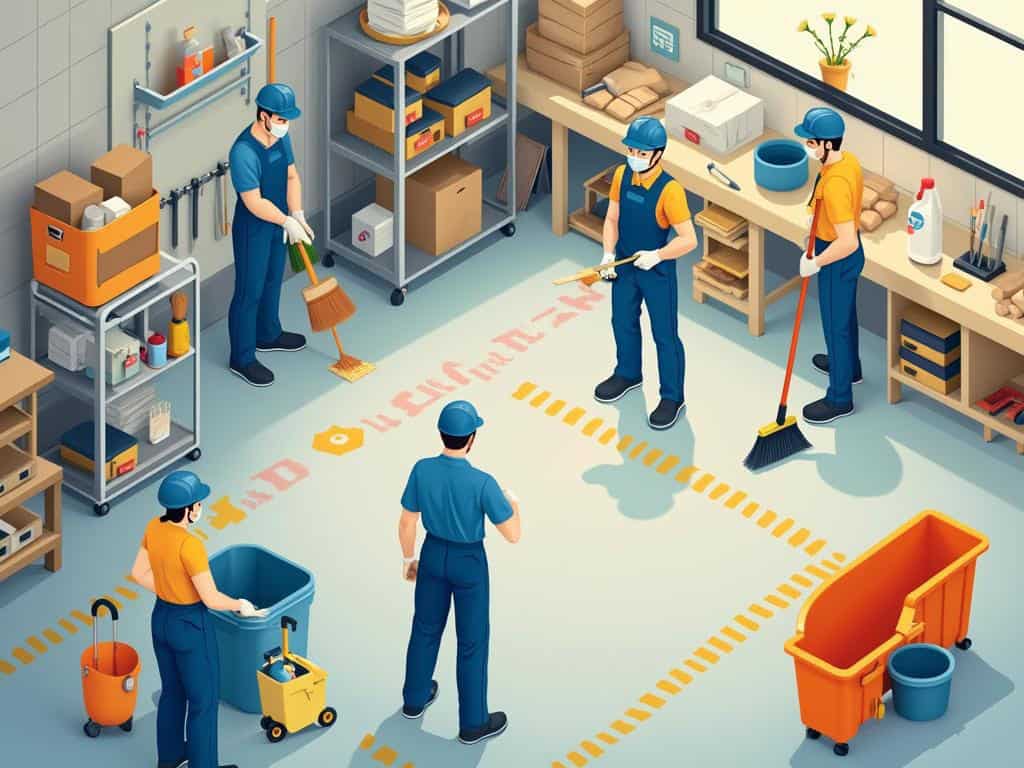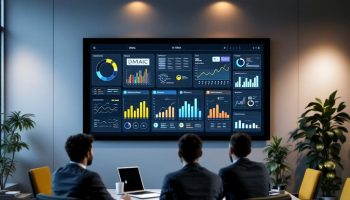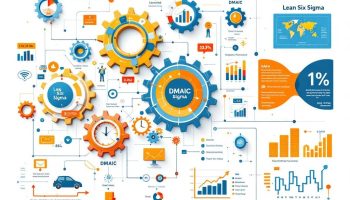
The 5S Lean Principles for Workplace Efficiency
The 5S lean principles—Sort, Set in Order, Shine, Standardize, and Sustain—provide a systematic framework for transforming workplace efficiency and organization. By methodically removing clutter, strategically organizing, maintaining cleanliness, establishing consistent procedures, and embedding these practices into organizational culture, businesses can significantly improve productivity, safety, and operational performance.
Key Takeaways:
- The 5S lean principles offer a comprehensive approach to workplace optimization, addressing physical organization and cultural transformation.
- Implementing 5S can reduce workplace inefficiencies, with potential productivity improvements up to 25-30%.
- Each 5S principle builds upon the previous one, creating a holistic system for continuous improvement.
- Successful 5S implementation requires commitment from leadership and active participation from all team members.
- The methodology goes beyond simple tidiness, focusing on creating a culture of proactive maintenance and efficiency.
Workplace organization directly impacts your bottom line. Research shows that employees waste approximately 76 hours per year searching for misplaced items in the office. The 5S system addresses this problem head-on with practical solutions.
You’ll find immediate benefits after implementing these principles. Safety hazards decrease, production flow improves, and equipment maintenance becomes more efficient. The lean methodology has transformed manufacturing environments worldwide, but its applications extend to healthcare, retail, and administrative settings as well.
Many organizations start with high enthusiasm but struggle with long-term adoption. The key lies in consistent application and creating habits rather than one-time cleanup events. Regular audits and visual management tools help maintain momentum after the initial 5S implementation phase completes.
“Embracing the 5S lean principles transforms not just the physical workspace, but also the very culture of an organization, fostering a mindset of continuous improvement and efficiency. When commitment to these principles is woven into the fabric of a company, the result is a powerful synergy that can boost productivity by 25-30%, paving the way to a safer and more organized environment.”
Sort (Seiri): Decluttering for Maximum Efficiency
Sort, the first of the 5S lean principles, focuses on identifying and removing unnecessary items from your workplace. This critical step forms the foundation of workplace efficiency by eliminating clutter that slows productivity and creates safety hazards. You’ll need to make tough decisions about what stays and what goes to create a leaner operation.
The red tagging technique is a powerful tool in the Sort phase. This method helps you systematically identify items that aren’t essential to daily operations. By attaching red tags to questionable items, you’re forced to evaluate each one’s necessity. The 5S lean principles guide you to consider factors like frequency of use, importance to operations, and proper storage locations.
Benefits of Effective Sorting
When you properly implement the Sort phase of the 5S lean principles, you’ll experience several measurable benefits:
- Reduced floor space requirements that can be repurposed for value-adding activities
- Lower safety risks through elimination of tripping hazards and blocked emergency exits
- Decreased time wasted searching for tools and materials
- Improved inventory management with fewer obsolete items
- Enhanced visual workplace management and control
A data-driven approach to waste elimination is essential during the Sort phase. You should track metrics like floor space reclaimed, safety incidents prevented, and time saved searching for tools. These metrics provide concrete evidence of the continuous improvement benefits stemming from this first 5S lean principle.
Successful Sort implementation requires commitment from all team members. You’ll need to collaborate effectively to determine what’s truly necessary and what can be eliminated. This collective decision-making builds ownership of the 5S lean principles across your organization.
Remember that Sort isn’t a one-time event but an ongoing process. Regular sorting activities should be scheduled to prevent clutter from returning. By consistently applying this first 5S lean principle, you create the space and clarity needed for the remaining principles to succeed. The Sort phase establishes the clean slate upon which you’ll build a more efficient and organized workplace.
Organizational efficiency can improve by as much as 25% when implementing effective sorting and decluttering strategies in the workplace.
forbes.com
Set in Order (Seiton): Strategic Workplace Organization
After you’ve sorted out unnecessary items, the next 5S lean principle focuses on organizing what remains. Set in Order (Seiton) ensures everything has a designated place and stays there when not in use. This critical principle reduces wasted time searching for tools and materials while establishing a more efficient workflow.
You’ll achieve significant time savings through proper implementation of the 5S lean principles, particularly Set in Order. Research indicates that workers can waste up to 30% of their time looking for materials and tools in disorganized workplaces. By strategically organizing necessary items, you’ll eliminate this waste and boost productivity immediately.
The 5S lean principles emphasize using visual management tools to make organization intuitive. These include:
- Shadow boards that outline where tools belong
- Floor markings to designate workstations and traffic areas
- Color-coding systems for easy identification
- Labeled storage areas with clear inventory levels
- Kanban systems for supply management
Consider ergonomics when implementing the 5S lean principles during your Set in Order phase. Place frequently used items within easy reach to reduce unnecessary movement and strain. You’ll want to position heavier items at waist level to minimize lifting injuries while keeping seldom-used items in less accessible locations.
Workflow Efficiency Through Strategic Placement
The 5S lean principles aim to minimize motion waste by organizing workspaces around actual work processes. By mapping your workflow first, you can place tools and materials exactly where they’re needed in the sequence of operations. This strategic approach to the 5S lean principles creates a continuous improvement cycle that constantly refines workplace organization.
When properly executed, Set in Order transforms chaotic workspaces into efficient, intuitive environments. The 5S lean principles work together to create visual workplaces where abnormalities become immediately apparent. You’ll notice problems faster and solve them more efficiently when everything has a clear, designated place.
For effective implementation of this phase of the 5S lean principles, create a detailed placement plan. Document where items belong using photographs, diagrams, and written instructions. These visual references reinforce proper organization and make it easier for everyone to maintain the system.
The 5S lean principles encourage involving frontline workers in determining optimal item placement. Their practical experience provides valuable insights into workflow efficiency that managers might miss. This collaborative approach to the 5S lean principles also increases buy-in and compliance with the new organizational system.
Remember that Set in Order works best after a thorough Sort phase. The 5S lean principles follow a logical sequence, with each step building on the previous one. You’ll find project communication becomes more effective when everyone knows where to find information and resources thanks to these organizational principles.
Expert Insight: To maximize workplace efficiency through the Set in Order (Seiton) principle of 5S, ensure that every tool and material has a designated place, reducing time spent searching for items. Implement visual management tools such as shadow boards, floor markings, and color-coding systems to make organization intuitive and maintainable for all team members. Involve frontline workers in the placement process, leveraging their insights to enhance workflow and encourage ownership of the organizational system, ultimately leading to a more productive and seamless work environment.
Shine (Seiso): Maintaining a Clean and Proactive Environment
The third pillar of the 5S lean principles, Shine (Seiso), focuses on creating and sustaining a spotless workspace through comprehensive cleaning and maintenance procedures. You’ll find that a clean environment isn’t just about appearances—it’s a fundamental aspect of operational excellence that drives efficiency and prevents equipment failures.
Regular cleaning and maintenance serve as your first line of defense against equipment degradation. By implementing the 5S lean principles effectively, you can identify potential issues before they escalate into major problems. Oil leaks, loose parts, or unusual noises become immediately apparent in a clean workspace, allowing for proactive risk response planning rather than reactive repairs.
The benefits of implementing Shine extend beyond equipment longevity. A clean environment directly impacts product quality by reducing contamination risks and defects. You’ll also notice significant improvements in workplace safety as slip hazards, obstructions, and other dangers are promptly addressed through consistent 5S lean principles application.
Creating Effective Cleaning Protocols
To successfully implement Shine, you need structured cleaning protocols with clear responsibilities and schedules. Here’s how to establish an effective Seiso system:
- Develop detailed cleaning checklists for each work area
- Assign specific responsibilities to team members
- Create visual cleaning standards with before/after photographs
- Establish regular inspection routines to verify compliance
- Provide necessary cleaning tools and supplies at designated stations
The Shine component works best when integrated with the other 5S lean principles through continuous improvement initiatives. By making cleaning an integral part of daily work rather than an occasional activity, you’ll embed proactive maintenance into your organizational culture.
This consistent approach to cleanliness creates a workplace where abnormalities stand out immediately. When tools, equipment, and work areas maintain a baseline level of cleanliness, deviations become obvious signals requiring attention. This visual management aspect of Shine enhances your ability to identify and address issues before they impact operations.
Remember that Shine isn’t just about aesthetics—it’s about creating an environment where problems can’t hide. By implementing this critical element of the 5S lean principles, you’ll establish a foundation for improved quality, enhanced equipment reliability, and increased workplace safety.
Companies that prioritize cleanliness can reduce their equipment downtime by as much as 25%, leading to significant improvements in productivity and operational efficiency.
forbes.com
Standardize (Seiketsu): Creating Consistent Procedures
Standardization is the fourth pillar of the 5s lean principles that takes your workplace organization efforts to the next level. After sorting, setting in order, and shining, you’ll need consistent procedures to maintain these improvements. The Standardize step ensures everyone follows the same practices, reducing variability and preventing backsliding into old habits.
You’ll see immediate benefits when implementing standardization in your workplace. By developing uniform work instructions, you can reduce operational mistakes by up to 30% while creating a foundation for continuous improvement. Standardization doesn’t mean rigidity – it means establishing clear baselines that allow for efficient problem identification and resolution.
Key Components of Effective Standardization
To implement the Standardize phase successfully, focus on these essential elements:
- Visual workplace controls: Use color-coding, signage, and visual aids to communicate standards instantly
- Standard operating procedures (SOPs): Create clear, concise documentation that anyone can follow
- Regular audits: Establish checklists and evaluation criteria to ensure 5s lean principles are maintained
- Assigned responsibilities: Clearly define who handles what areas to ensure accountability
- Training systems: Develop consistent onboarding materials to bring new team members up to speed quickly
The real power of standardization emerges when you incorporate it into daily workflows. By implementing continuous improvement practices alongside standardization, you’ll create a system that naturally identifies and addresses inefficiencies.
A standardized workplace also makes project integration management significantly more straightforward. When procedures are consistent, you can more easily identify where processes intersect and optimize those connections for maximum efficiency.
| Standardization Element | Purpose | Implementation Example |
|---|---|---|
| Visual Management | Instant communication | Color-coded zones, shadow boards |
| Work Instructions | Consistent execution | Step-by-step guides with images |
| Audit System | Performance measurement | Weekly 5s lean principles checklist |
| Training Matrix | Skill development | Documented training progression |
| Responsibility Chart | Accountability | Clear assignment of cleaning/maintenance duties |
Remember that standardization doesn’t mean perfection from day one. You’ll continuously refine your standards as you identify better practices. The goal is to create a workplace where the 5s lean principles become second nature, allowing your team to focus on value-adding activities rather than searching for tools or deciphering unclear procedures.
Companies that standardize their processes can reduce errors and increase productivity by up to 30%.
hbr.org
Sustain (Shitsuke): Embedding 5S into Organizational Culture
The fifth and final principle of the 5s lean principles focuses on sustaining all improvements made through the previous steps. Shitsuke (Sustain) transforms temporary changes into permanent habits, ensuring your organization doesn’t slip back into old, inefficient patterns. This stage requires both leadership commitment and employee buy-in to create lasting cultural change.
You’ll need to develop strategies that reinforce the 5s lean principles daily. Regular audits help identify areas where standards might be slipping, while recognition programs celebrate teams that consistently maintain high 5s standards. Creating a dedicated 5s committee can help oversee ongoing implementation and address challenges as they arise.
Building a Culture of Continuous Improvement
Embedding 5s into your organization’s DNA requires deliberate effort. Here are effective approaches to sustain your 5s implementation:
- Regular training sessions to refresh knowledge and train new employees
- Visual management boards showing 5s performance metrics and improvements
- Scheduled 5-minute daily 5s activities at shift start or end
- Leadership gemba walks to demonstrate commitment to 5s standards
- Employee-led 5s improvement suggestions and implementation
- Cross-functional 5s teams to share best practices across departments
The sustainability of your 5s program depends heavily on leadership engagement. When managers actively demonstrate project leadership by participating in 5s activities, employees recognize its importance. This commitment signals that 5s isn’t just another initiative but a fundamental way of operating.
Developing formal sustainability mechanisms helps prevent backsliding. You can implement continuous improvement processes by establishing regular 5s audits, creating standardized checklists, and tracking measurable metrics that demonstrate the business impact of your 5s implementation.
The following table outlines key components for sustaining 5s implementation:
| Sustainability Component | Purpose | Implementation Approach |
|---|---|---|
| Regular Audits | Verify standards maintenance | Weekly or monthly assessments using standardized checklists |
| Visual Controls | Provide clear expectations | Photographs, diagrams, and color-coding showing proper conditions |
| Recognition Programs | Motivate ongoing participation | Celebrating teams/individuals maintaining excellent 5s standards |
| Accountability System | Establish responsibility | Clear ownership of areas and tasks with performance tracking |
| Integration with Objectives | Align with business goals | Incorporating 5s metrics into performance reviews and KPIs |
When you consistently apply the 5s lean principles throughout your organization, you’ll create a self-sustaining system where orderliness, cleanliness, and efficiency become second nature. This cultural transformation forms the foundation for broader lean initiatives and operational excellence.
Implementing 5S: Practical Applications and Benefits
You can transform your workplace through the strategic implementation of 5S lean principles. These fundamental principles create a foundation for continuous improvement by systematically organizing and optimizing your work environment. The 5S methodology (Sort, Set in Order, Shine, Standardize, and Sustain) delivers measurable benefits across various industries.
Strategic Implementation Approach
Start by conducting a comprehensive workplace assessment to identify areas needing improvement. Document the current state with photos and metrics to establish your baseline. When implementing 5S lean principles, you’ll need to:
- Develop a detailed implementation plan with clear timelines
- Form dedicated 5S teams with representatives from different departments
- Provide thorough training on 5S lean principles and techniques
- Create visual management tools like shadow boards and floor markings
- Establish regular audit processes to maintain standards
The benefits of implementing 5S lean principles extend beyond just organization. You’ll experience continuous improvement through reduced search times for tools and materials. Workplace safety improves significantly as hazards are eliminated and pathways remain clear. One manufacturing facility reported a 30% reduction in workplace accidents after implementing 5S.
The 5S lean principles also drive significant productivity gains. Workers spend less time searching for items and more time on value-adding activities. Equipment reliability improves through regular maintenance practices established in the “Shine” phase. Quality defects decrease as standardized processes reduce variation and mistakes.
For successful implementation, ensure leadership demonstrates visible commitment to the 5S lean principles. Create lean waste reduction competitions between departments to maintain enthusiasm. Document improvements with before-and-after photos and share success stories across the organization.
Remember that 5S isn’t a one-time project but a continuous journey. Your workplace transformation requires ongoing commitment to sustain the gains achieved through these 5S lean principles. The investment in implementing 5S pays dividends through enhanced efficiency, reduced waste, and a more engaged workforce.






